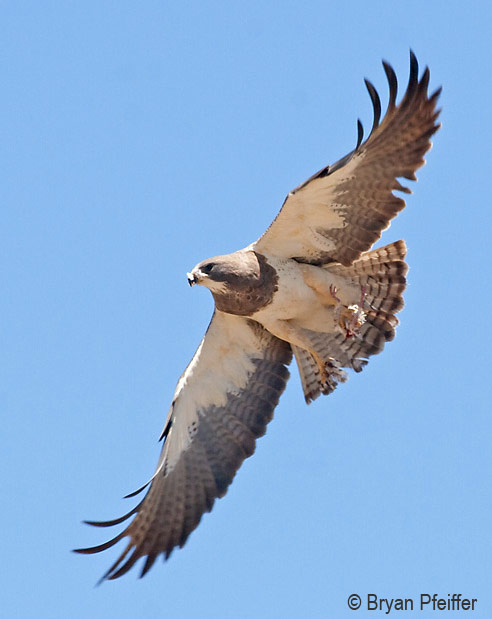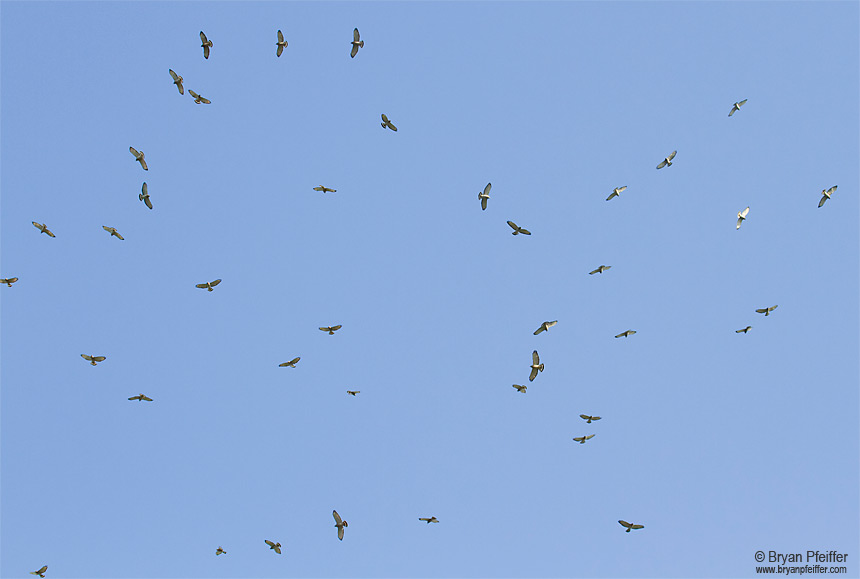Hawkwatching Confidential

Red-tailed Hawk (without a red tail) / © Bryan Pfeiffer
Pack a lunch, climb a mountain, and witness thousands of hawks gliding south over hills blazing with fall foliage. If only this romanticized rite of autumn were so easy. If only migrating hawks didn’t appear like specks of pepper cast to the winds, the birds of prey preying on a birder’s self-confidence. So here’s some advice for fledgling fall hawkwatchers.
First, yeah, find a mountain. You’ll want a high perch from which to see lots of sky. But not just any mountain will do. Go to established hawk-watching sites (more on those later), where the topography conspires to funnel southbound hawks in large numbers. Up there, you’ll also find birders willing to share their hawkwatching wisdom.
Next, check the forecast for a classic fall day. Cool north winds and full or partial sun are the fuel for hawk migration. By late morning, sunshine warms the valleys, releasing thermals with hawks along for the lift. At least that’s the idea; even on perfect days sometimes the hawks don’t cooperate.
But when they do, it often goes like this: You finally spot your first hawk…then another, and another, then three more, and as you brush your binoculars back and forth, up and down across the sky, you’ve discovered a kettle – hundreds of hawks, specks of pepper to be sure, but some of them drifting close enough to identify.
Identification Rule Number One: It’s a broadwing. The Broad-winged Hawk is the most abundant and reliable fall hawk in the Northeast (with rare exceptions – see John’s comment below). Small, stocky, and circling on flat, pointed wings, broadwings are themselves an event. Although they move south from late August into November, their numbers often surge from September 10-20, when broadwings constitute the vast majority of hawks we see in the skies. Here is your opportunity to learn and enjoy Broad-winged Hawks from every angle. And from that blizzard of broadwings, your next challenge is to find birds that are not broadwings.

Swainson’s Hawk, a westerner, rare in the East / © Bryan Pfeiffer
Which brings me to Rule Number Two: Abandon plumage. Skilled hawkwatchers can distinguish every eastern hawk, eagle, or falcon species by shape and style of flight alone. Give us a flapping silhouette in the sky, and we’ll put a name on it. After all, immature Red-tailed Hawks don’t have red tails and immature Bald Eagles don’t have white heads. In the same way we use shape to separate pointy-winged falcons from broader-winged hawks in flight, practiced hawkwatchers use subtler differences to separate similar species. Once you know the shape and flap of a broadwing, for example, you may more easily discover Red-shouldered Hawks by their slightly longer wings with more squared tips. (You won’t see red shoulders.)
The same goes for eagles – and Rule Number Three: It’s not a Golden Eagle. Okay, it might be. But Golden Eagles are rare in the east. Many a Golden Eagle report is actually of an immature Bald Eagle, which has a huge head and beak that project well forward of the wings, more so than on a smaller-headed Golden Eagle. Bald Eagles, which are regulars at fall hawkwatching sites, often hold their wings flat or slightly drooped; Golden Eagles mostly hold theirs in a slight but noticeable dihedral.
Until the weather’s right and you get yourself up a mountain, here’s some homework: Consult the Hawk Migration Association of North America’s web site to locate a hawk-funneling mountain near you and download free guides to hawk identification. Augment your own field guides with Hawks at a Distance, by Jerry Liguori.
Finally, Rule Number Four: Be skeptical of rules and generalizations (including mine). You may encounter migrating hawks away from mountains, even over cities. And hawks won’t always be so distant. Now and then they glide low overhead, exposing their classic field marks (so use them when you see them), along with grace, force, and intensity, producing some of the best “ooh-ahh” moments in all birding. But even when they don’t, or even when hawks don’t show up at all – hey, at least you’re on top of a mountain.

A kettle of Broad-winged Hawks / © Bryan Pfeiffer

Where DID you get the Swainson’s hawk?
Hi Ray, Where they belong: Southeastern Arizona. I’ve never seen one in the East.
Well, here in Central/Western MA, the Broadwings rule during our migration. We do get a good mix though, and experience helps.
Let me bust one balloon. They are not all Broad-wings. Here in the Finger Lakes Broadwings are the exception for some reason. We have other generalizations. 😉 Eagles can indeed be Golden and around here we have a reliable Golden migration that is stronger in spring than in fall. Being in between to the ridge route favored by adults and the coastal route favored by young of the year raptors, we get a nice mixture of confused raptors that serve to further confuse the hawk watcher!
Thanks, John. Yeah, it is odd over at Finger Lakes. I’ve looked at data. Yep, my Generalization Number 4 was: Be skeptical of generalizations. Here in New England, they’re fairly good. They’re broadwings — at least tomorrow they will be. And they won’t be Golden Eagles. In any event, enjoy your flight!